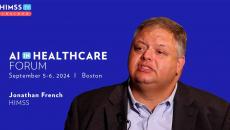Quality and Safety
HIMSS' new Policy Principles for Artificial Intelligence and Machine Learning focus on safety and trust; transparency and privacy; and workforce and sustainability. Jonathan French, senior director of public policy at HIMSS explains more.
What does the next year in AI and genAI look like? How can and must AI help with the clinician shortage? Is fearmongering detrimental to AI's future? Greg Miller, vice president of business development at Carta Healthcare, has the answers.
Michael Pencina, director of Duke AI Health, sees big potential but also fundamental challenges as providers try to figure out what tools to use, where and when to use them, and for what purposes.
Atlantic Health System Chief Information & Digital Officer Sunil Dadlani explains how AI and security "aren't mutually exclusive, they're mutually inclusive."
Northeast Georgia Health System has deployed real-time location service and internet of things technologies to help healthcare workers in trouble. Chris Paravate, the health system's CIO, explains.
Radiation oncologist Dr. Raghav Murali-Ganesh, cofounder and CEO of Osara Health, shows how tracking symptoms can help patients live 30% longer compared with those who don’t write down how they feel.
Imprivata engineering chief Joel Burleson-Davis discusses new IAM strategies, including a potential future without passwords.
Leah Binder, Leapfrog's president and CEO, says the structural measure for 2025 will assess whether hospitals have a structure and culture that prioritizes safety in care delivery.
There's a direct link between achieving EMRAM Stage 6 or 7 and higher quality and safety results, explains Anne Snowdon, HIMSS Chief Scientific Research Officer after examining Leapfrog data from 2,000 U.S. hospitals.
DarioHealth's experience with self-insured employers bending costs by employing digital therapeutics while simultaneously supporting individuals with chronic conditions has been illuminating, says the company's CMO, Dr. Omar Manejwala.























